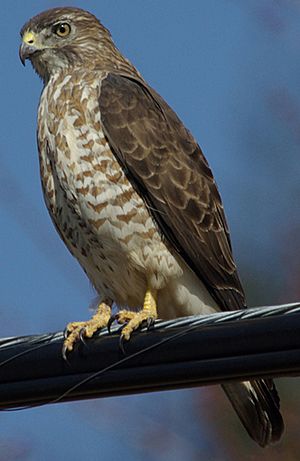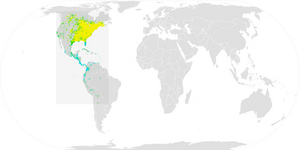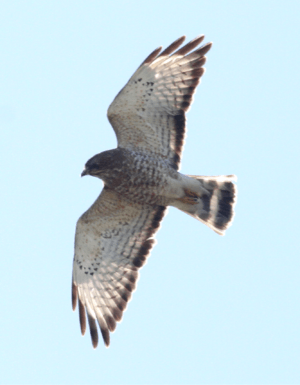Broad-winged hawk facts for kids
Quick facts for kids Broad-winged hawk |
|
|---|---|
 |
|
| Conservation status | |
| Scientific classification | |
| Genus: |
Buteo
|
| Species: |
platypterus
|
 |
|
| Global map of eBird reports of this species Year-Round Range Summer Range Winter Range | |
The broad-winged hawk (Buteo platypterus) is a medium-sized bird of prey. It belongs to a group of hawks called Buteo hawks. These birds live in eastern North America during the summer. They can be found as far west as British Columbia and Texas.
When winter comes, they migrate south to warmer places. They fly to the Neotropics, which stretches from Mexico all the way to southern Brazil. Some broad-winged hawks live on Caribbean islands all year round. Like most birds of prey, female hawks are a bit bigger than males. Their wings are short and wide, with a somewhat pointed shape. Broad-winged hawks can be either dark brown or a lighter, paler color. Even though there are many broad-winged hawks, their numbers are slowly going down in some areas. This is because their forest homes are getting broken up into smaller pieces.
Contents
What They Look Like

The broad-winged hawk is a fairly small hawk. It is about 32 to 44 centimeters (13 to 17 inches) long. It weighs between 265 and 560 grams (9.3 to 19.8 ounces). Its tail is quite short, measuring about 14.5 to 19.0 centimeters (5.7 to 7.5 inches). Female broad-winged hawks are a little larger than the males.
These hawks have short, wide wings that look pointed at the ends. This unique wing shape helps identify them. Their wingspan can be from 74 to 100 centimeters (29 to 39 inches) wide. Adult hawks have dark brown bodies. Their bellies and chests are white with horizontal stripes. Their tails are dark gray-black with white bands in the middle, at the base, and at the tip.
Young hawks have slightly different colors. They have more white and vertical stripes instead of horizontal ones. Some broad-winged hawks are a "dark morph," meaning they have fewer white areas. Others are a "light morph," which means they are paler overall. The light morph can sometimes be confused with the red-shouldered hawk. However, the broad-winged hawk has a shorter, more striped tail. Its wings also have a solid reddish-brown color when it's an adult.
Hawk Families
This hawk species, Buteo platypterus, belongs to the family called Accipitridae. This family includes many birds of prey like eagles and kites. It is part of the larger group called Falconiformes (or Accipitriformes).
There are six different types, or subspecies, of broad-winged hawks. Each one is named for where it lives:
- B. p. platypterus – This is the northern broad-winged hawk. It lives across much of eastern North America.
- B. p. brunnescens – This is the Puerto Rican broad-winged hawk. It lives in the karst forests of Puerto Rico.
- B. p. cubanensis – This is the Cuban broad-winged hawk. It lives on Cuba.
- B. p. insulicola – This is the Antigua broad-winged hawk. It lives on Antigua.
- B. p. rivierei – This is the Dominican broad-winged hawk. It lives on Dominica, Martinique, and St. Lucia.
- B. p. antillarum – This is the Antillean broad-winged hawk. It lives in the Lesser Antilles, from Saint Vincent and Grenada to Tobago.
Where They Live and Travel
Broad-winged hawks live in a wide area. They can be found from southern Canada all the way to southern Brazil. Their breeding grounds are in the northern and eastern parts of North America. In winter, many of them migrate to places like Florida, southern Mexico, and northern South America.
Five of the subspecies live only in the Caribbean and do not migrate. The hawks that do migrate fly in huge groups. These groups can have more than 40 birds, sometimes even thousands! They fly at heights of 550 to 1300 meters (1,800 to 4,300 feet). They use warm air currents called thermals to help them soar. This helps them travel long distances, from 3,000 to 6,000 kilometers (1,900 to 3,700 miles).
Their fall migration takes about 70 days. The birds fly about 100 kilometers (60 miles) each day. They travel from North America, through Central America, to South America. They do not fly over large bodies of salt water. These huge groups of soaring broad-winged hawks are called "kettles." You can see these amazing hawk migrations at places like Hawk Cliff in Ontario and Hawk Mountain in Pennsylvania.
Broad-winged hawks usually stay in areas up to 2,000 meters (6,600 feet) high. They build their nests in deciduous forests. These are forests where trees lose their leaves in the fall. They hunt for food mostly in wetlands and meadows. While some hawks live near people, they usually avoid human towns and interactions. In winter, the migrating hawks look for similar forest conditions. They settle in deciduous and mixed forests.
Even though their numbers are going down in some places due to forests being cut up, overall, there are still many broad-winged hawks. Because of this, they are listed as "least concern" on the IUCN Red List. This means they are not currently in danger of disappearing.
How They Behave
Sounds They Make
Broad-winged hawks use different sounds to talk to each other. They use calls to communicate with their mates and their young. They also use sounds to show other animals that an area is their territory. For example, they might call out to warn off red-tailed hawks or other threats. Their call sounds like a very high-pitched "kee-ee," almost like a whistle. If they feel threatened, they make an alarm call. This call is made of stuttering and squealing whistles.
What They Eat
Broad-winged hawks are carnivores, meaning they eat meat. The type of food they eat changes with the seasons. During the summer, when they are nesting, the parents and their chicks eat small mammals. These include chipmunks, shrews, and voles. They also eat frogs, lizards, and sometimes even other nesting birds.
In the winter, they have been seen eating insects, frogs, snakes, crabs, and some small mammals. To catch their food, broad-winged hawks hide in the leaves of low branches. They watch carefully until they spot something. Then, they make a short, fast glide to catch their prey. They are careful when preparing their food. They will skin frogs and snakes. They also pull out the feathers of birds they catch. Most small mammals, however, are eaten whole. These hawks rarely drink water. They get all the water they need from the food they eat.
How They Reproduce
These birds usually have only one mate during the breeding season. The male hawk helps a little bit with raising the chicks. They breed between April and August. They start breeding when they are about two years old.
To attract a female, the male hawk performs a special courtship display flight. This includes doing cartwheels, dives, and other amazing moves in the air. Sometimes, birds meet in the air, hook their feet together, and spiral down. Males also compete with each other to mate with a female. If a male is successful, the pair will have one group of young that season. This group usually has one to four eggs.
Both the male and female build the nest. They use sticks and twigs to build it in a deciduous tree. Once the eggs are laid, they are usually about 49 by 39 millimeters (1.9 by 1.5 inches) and weigh about 42 grams (1.5 ounces). The eggs are spotted brown. The female then sits on the eggs to keep them warm. This is called incubating. She incubates the eggs for 28 days or more until they hatch.
When the chicks hatch, they are semi-altricial. This means they can't do much on their own. But their eyes are open, and they are covered in soft down feathers. The chicks grow very quickly until they are almost the size of an adult. At this point, they can walk, fly, and eat by themselves. While the chicks are in the nest, the female does most of the parental care. She protects them and brings them food. The male might bring some food for the female and the chicks, but his visits are usually short.
When food is brought to the nest, the female tears off pieces and feeds them to the chicks. She does this until they are old enough to tear meat off on their own. Often, the chicks will fight over the food. The younger ones usually lose and don't get enough to eat.
Broad-winged hawks protect their nests by acting aggressively. They might dive at or chase away anything they see as a threat. However, they usually do not make physical contact. Animals that might try to eat their eggs and young include raccoons, crows, porcupines, and American black bears. Adult hawks have been known to be caught by red-tailed hawks, great horned owls, bald eagles, and golden eagles. The young hawks need 5 to 6 weeks before they can leave the nest. Some young birds stay near the nest for several more weeks even after they can fly.
See also
- Broad-winged hawk species account at Neotropical Birds (Cornell Lab of Ornithology)
- In Spanish: Gavilán aliancho para niños



